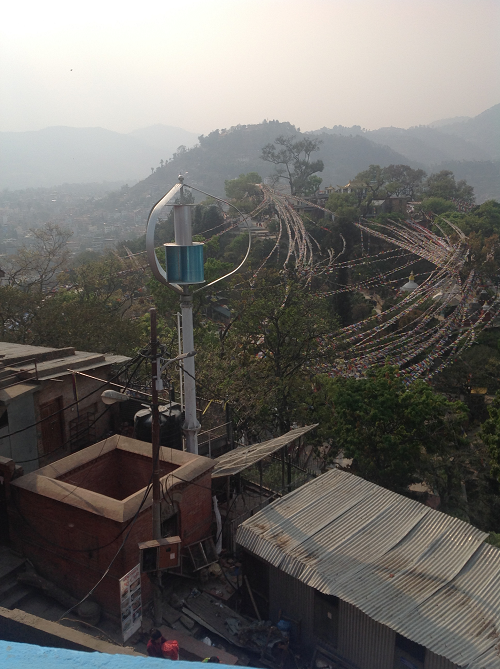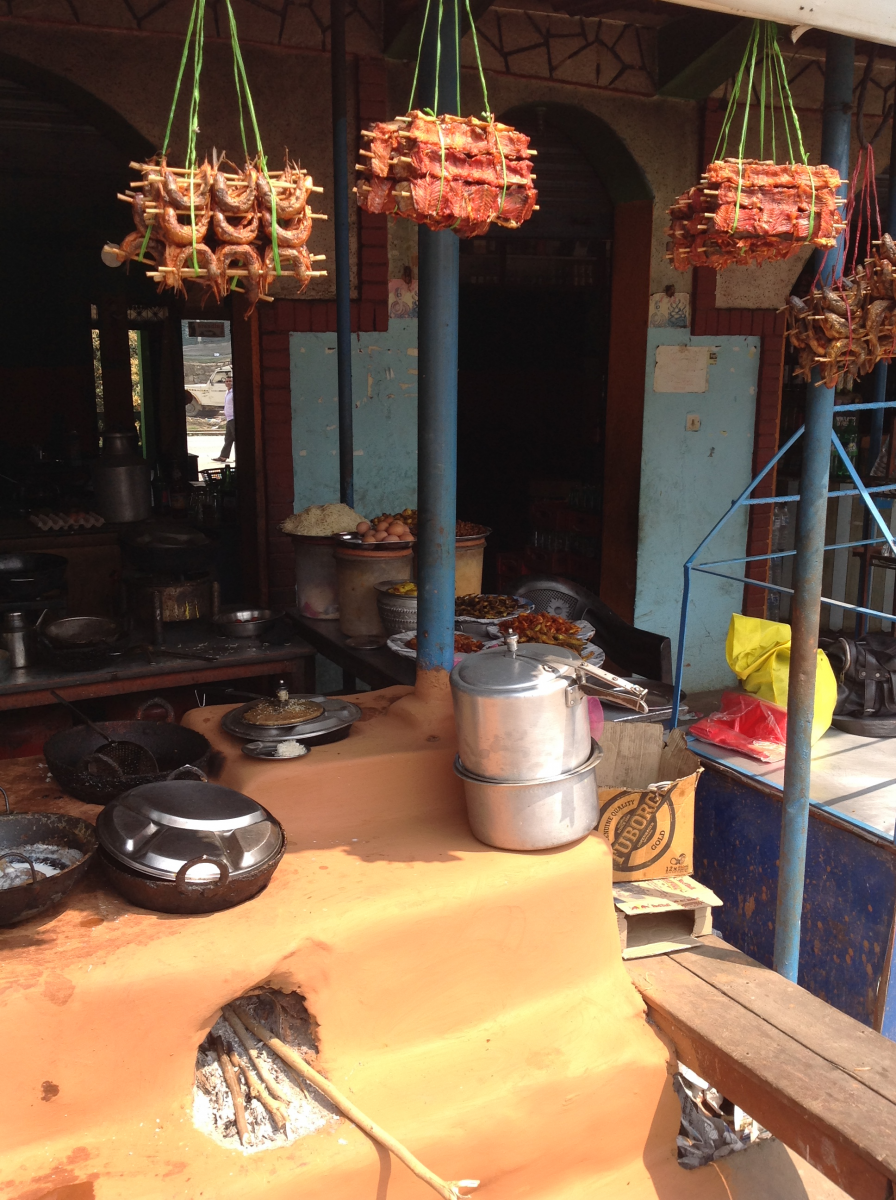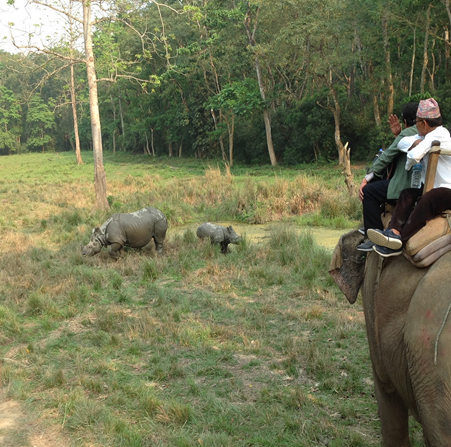
In this blog, Dr Jonathan Cloke (National Network Manager, LCEDN) reports on the success of the 5th International Conference on Developments in Renewable Energy Technology (ICDRET) 2018, and falling in love with Kathmandu... The main image (right) shows a wind-turbine on top of the Swayambhunath Buddhist Template in Kathmandu.
It was a motley crew from the LCEDN that made their diverse ways to Kathmandu for the ICDRET 5th conference in Kathmandu, as part of the UK support for the DfID-funded Transforming Energy Access (TEA) programme. We were alternately worn down by the prolonged delays in Dubai, the torture-lite conditions of the FlyDubai flight to Nepal and the confusing, surreally-serpentine migration queues at the Tribhuvan International airport. Even Dr Ben Campbell’s habitual serene optimism, honed to near-perfection by 30 years of flying in and out of Nepal, had been reduced to the occasional gnomic squawk as he chewed his beard.
The LCEDN became involved with the organisation of this edition of the ICDRET because we see the ICDRET conference as a great opportunity to expand our growing portfolio of international transdisciplinary connections in energy and development amongst our members across the world; because we’re on a mission to spread the gospel of trans-disciplinarity in low carbon transitions globally; and because no-one else would invite us...
The LCEDN’s approach to concentrating on socio-technical approaches to inclusive low carbon energy solutions in the global south still has a lot of traction to gain amongst our more technically-minded colleagues and we saw ourselves as a highly-trained sociotechnical commando on an important mission. Plus, there was the shopping to consider….
.png)
The LCEDN had proposed a set of provocatively sociotechnical special sessions to try and manoeuvre our physical science brethren out of their comfort zones - Biogas: relevant scales of design, uptake and policy; Micro-hydro: social scales of success; Gender and energy services, contesting Energo-patriarchy; Resource governance lessons for off-grid energy systems (comparisons with Community Forestry, Commons Irrigation); Poverty dynamics (migration, post-conflict/disaster, informal settlements) and energy access; Collaborative Learning and Distributed Energy Resilience. To this end, we invited the participation of colleagues from India, Germany, the UK, Nepal, Bangladesh, Chile, Myanmar, the Philippines, South Africa and Ghana; this was an unmatched team of professionals representing a fiercely competent, shining example of sociotechnical expertise and practitioner expertise – and, of course, me.
By the time we arrived in Kathmandu, the original six sessions had been compressed by the other demands of the programme into four sessions over a total of 8 hours; these were intense sessions which were nonetheless extremely valuable in terms of their coverage and content. The first session on Day 1 had a blend of biogas and small hydro projects and analysis and which began with presentations by Govinda Devkota and Xavier LeMaire comparing lessons and experiences from the Nepal biogas extension program with examples from China, Cambodia, Rwanda and India and then moved on to Ben Campbell, who gave an exposition of his decades-long experience working in Langtang national park in Nepal with the development of a yak cheese factory.
The focus then moved more exclusively to Nepal with a statistical and empirical analysis of micro-hydro plants by Joe Butchers from the UK, a specific case study of the Syaurebhumi Micro Hydro plant in Nepal by Jiwan Kumar Mallik (which some LCEDN attendees had already had the privilege of visiting in a pre-conference trip) and an interesting example of a prototype water-wheel small hydro system (complete with water-wheel components!) by Stephan Baur and Lukas Geß from Germany, outlining how the prototype had performed in a mountain community in Nepal. The session was composed of a truly interesting set of projects and examples up and down the scale, which nicely encapsulated the need to take a multi-scalar approach to all aspects of decentralized renewable energy.

The second day was intense and included in the morning what was (to your blogger) the most fascinating of the sessions – electricity and energo-patriarchy, beginning with the example of gender and energy policy in India by Rengalakshmi , using the specific examples of LPG and the Ujjwala program to come to the conclusions (which I hope we would all agree with) that detailed use of assessing program results will result in increased agency for women if lessons are properly incorporated as well as increased efficiency in the use of clean energy in the household and in agriculture – involvement of women and increased efficiency are co-constitutive. Rengalakshmi was followed by Jyoti Devkota who provided a fascinating, in-depth statistical analysis of the impact of renewable energy on women in Nepal, to backstop more theoretical approaches to the effects of renewable energy with some facts and figures.
Next up were Bernie Jones, who provided an organizational analysis on behalf of Smart Villages concerning the importance of a gender focus in energy projects and the smart village agenda more generally, and Mini Govindan of TERI in India who used the example of energy projects in rural Bihar to emphasize the point that mere provision of electricity by itself will not contest energo-patriarchy and that there is really no such thing as a ‘gender neutrality’ in energy projects. The morning session was nicely book-ended by a move from the rural to the urban by two separate takes on the experiences of informal settlements in Bangladesh and Kathmandu. Raihana Ferdous (representing a team from Durham University in the UK) focused on the dependence on illicit energy sources researched by the Energy on the Move project funded by the UK government Department for International Development, a lesson that was reinforced by the presentation made by Nabraj Lama of Tribhuvan, who pointed out that the obstacles of bureaucracy and high prices for grid electricity in Kathmandu reinforced this trend, forcing informal settlers into further dependency on either traditional biomass bought in urban markets or secondary (frequently illicit) electricity supply.

The pressure to keep to the session time-slot meant that there was limited room for one or two questions, but the session chairs had to keep a tight rein on both the presenters and any questions. In one way this was a bit of a shame, since a more extended discussion in the case of at least some of the presentation was definitely warranted, but it also meant that a wide range of topics was levered into a focused, intense set of sessions where you really had to concentrate. Bernie Jones began the afternoon session speaking on the work of Smart Villages and the framework conditions for rural energy access, followed by a fascinating account of challenges to sustainable governance in CRE in Chile by Carla Lanyon; this presentation and the next one by Arianna Tozzi chimed big time with my own experiences with the solar nanogrids in Kenya and Bangladesh and we all agreed that there was definitely a paper to be written on similarities and contrasts between our wide variety of CRE experiences. For a complete change, Ayu Abdullah introduced us to the Minigrid Game, a bespoke piece of software comprising a virtual community energy project designed to teach people about the limitations of energy use and the need for cooperation, a novel and useful teaching tool which we were able to take for a trial run the next morning before the last session began. The afternoon ended with Tarek Ketelsen presenting the work of HPNET in Myanmar and, once again, I was in an area I had no previous knowledge of, marvelling at the sheer ingenuity of actors involved, whether NGO stakeholders, private sector and, occasionally, academic-practitioners like myself – the LCEDN sessions were bursting at the seams with innovative practices that made me want to visit these countries and projects immediately!
The sheer variety of different ways of looking at energy practices continued into the final session, led off by Angela Mae Minas looking at the role of support networks amongst farmers in the Philippines, and the network mapping presented here very much mirrored some of the primitive bits and pieces I’d been involved in with the LCEDN and with the nanogrids; Angela rightly pointed out the critical role of influence networks in spreading RE technologies and energy use practices, a sociotechnical issue that frequently gets left out of more technical project analyses. Jiska de Groot followed, giving an update on the Transforming Energy Access programme which the LCEDN has already been involved in, a typically robust performance from Jiska that reinforced the message she’d given about gender in the first plenary of the conference, in which she pinned back the ears of the engineering fraternity – very much male, very much technical. Our invited speaker Nana Asare Obeng-Darko from Ghana then came at the topic of energy from a very different, but no less important point-of-view; a researcher currently living in Finland, Nana broached the topic of legal, political and juridical norms across Africa as they affect the SDGs and the thorny topic of constructing effective policy frameworks that both educate the populace and expedite their connection to low carbon and decentralized energy.
Last but by no means least, the amazing Dipti Vaghela and her work with HPNET and the role of local practitioner networks in accelerating energy access, plainly something that we in the LCEDN hold very dear in our hearts. The amazing thing about Dipti is not just the expertise and enthusiasm that she brings to her topic, but the enormous breadth and depth of her contacts and experience. We’ve had the privilege of her attendance previously at the last LCEDN conference in Durham, but particularly since her expertise reflects the situation in Myanmar (about which very few people know much at all, would be my suggestion) and which seems to be a virtual paradise of CRE initiatives, we could only sit and listen with awe, hanging on to her every word..

